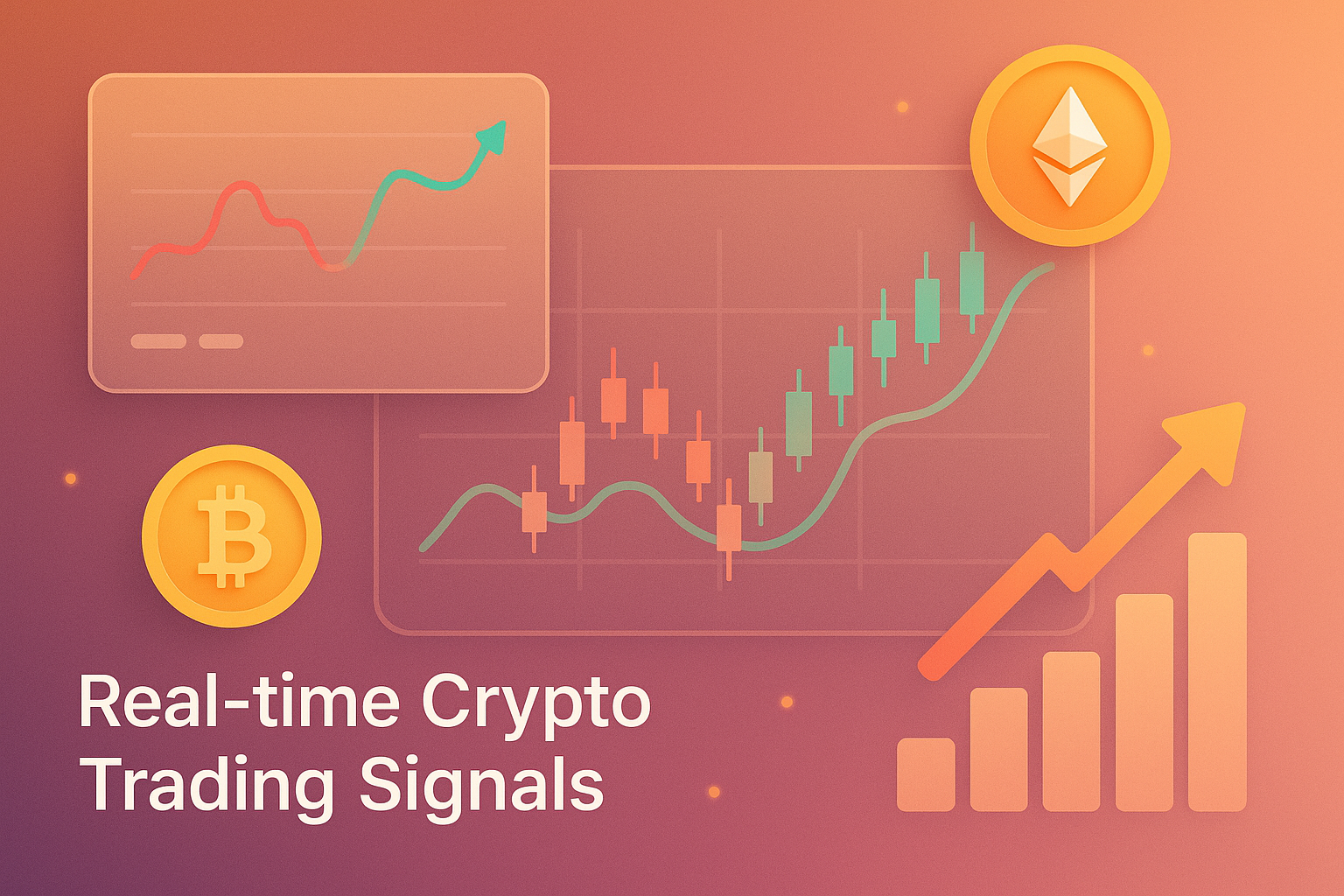Real-time crypto trading signals have become a lifeline for many traders. However, simply relying on them can cost you big time. So, here’s how to use these live alerts in a more efficient way.
In crypto, everything moves fast. One minute, Bitcoin is climbing. The next? It’s free-falling. That’s the thrill. But, also the challenge. Blink, and you might miss a golden opportunity. Or worse, walk straight into a loss. That’s where real-time crypto trading signals come in.
Think of them as your early-warning system. These live crypto alerts give you a heads-up. When to buy, when to sell, when to pause. No guessing. No stress. Just timely info designed to help you act fast and smart.
But how do these cryptocurrency signal updates actually work? Who sends them? And can you really trust them?
Don’t worry, we’re diving into all that. Whether you’re new to the game or just tired of being late to the party, this guide will walk you through everything you need to know. Clearly, simply, and without the fluff. Let’s get you trading like time is on your side.
What Are Real-Time Crypto Trading Signals?
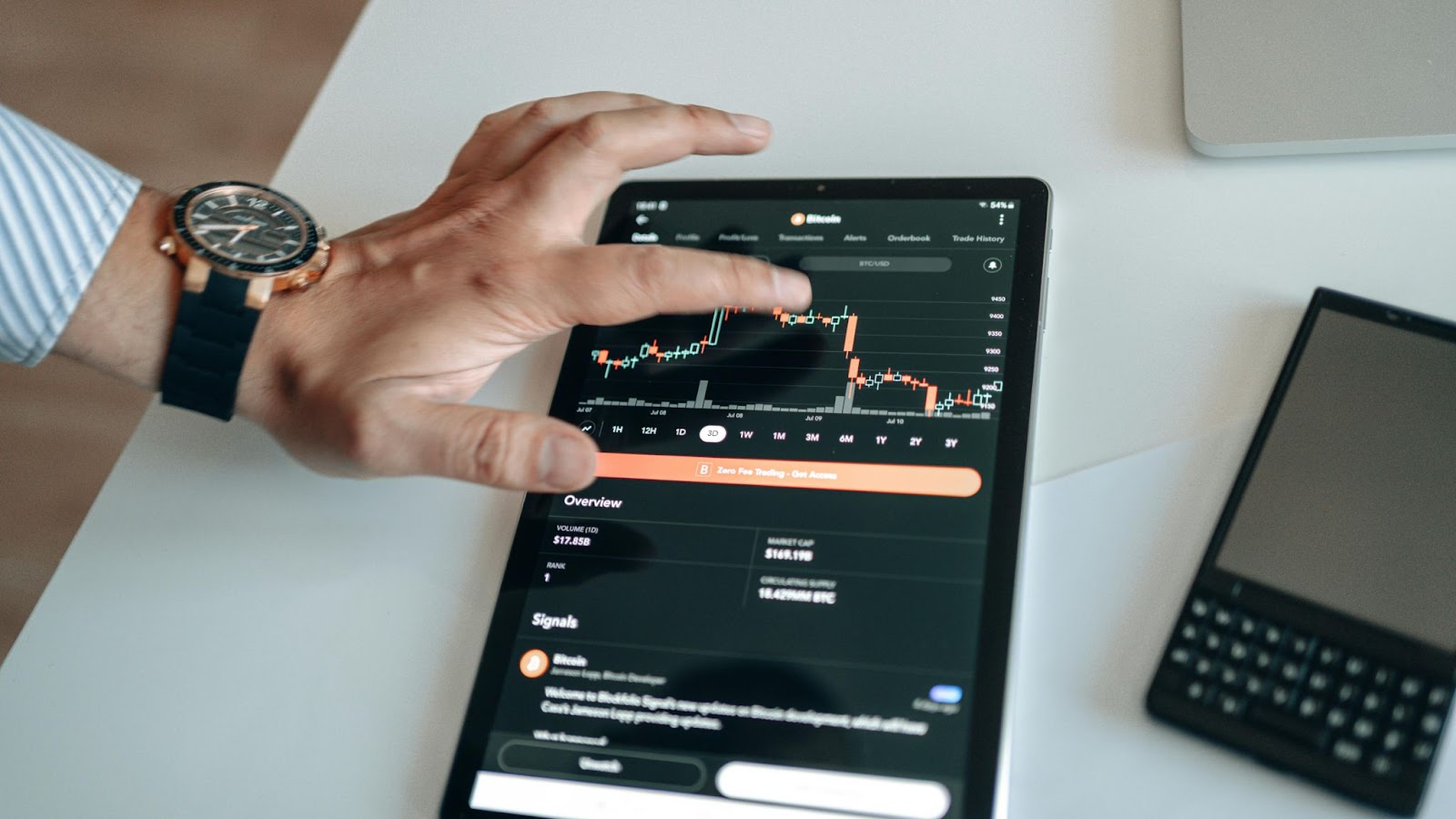
Imagine having a friend who watches the crypto markets 24/7 and taps you on the shoulder the second something big is about to happen. That’s basically what real-time crypto trading signals do.
They’re like insider tips. Except instead of rumors, they’re based on hard data, price patterns, and sometimes even AI. These cryptocurrency signal updates tell you when to buy, sell, hold, or steer clear. The goal? To help you make smart moves before the market shifts.
Manual vs Automated Signals
Now, not all signals are created equal.
Some are manual. That means there’s a human expert (or team) behind the curtain, analyzing charts, watching trends, and sending out alerts based on their knowledge and gut feel. These signals can be rich with insight, but they also take time. Humans can’t watch every chart, every second.
Then there are automated signals. These are powered by algorithms, bots, or even AI tools. They scan hundreds of data points in milliseconds. No coffee breaks, no sleep. If something unusual happens, boom! The signal fires instantly. Fast, consistent, and emotion-free.
Of course, both types have pros and cons. Manual signals can offer depth and reasoning, while automated ones shine when speed matters most.
Why Real-Time Crypto Trading Signals Really Matter
Now here’s where things get spicy.
“Real-time” means you get the alert as it’s happening. Not a few minutes later. Not after a blog post analysis. Right then and there.
This is a game-changer in crypto, where prices can spike or crash in seconds. Real-time crypto trading signals give you a chance to act before it’s too late. No more chasing missed pumps. No more panic-selling after a dip. Just timely, actionable info.
Think of it as the difference between getting a weather forecast the night before… or someone shouting “Umbrella!” right as the rain starts to pour.
So whether you’re swing trading, day trading, or just watching the markets for the perfect entry, real-time signals can help you stay ahead of the herd.
How Real-Time Crypto Trading Signals Work

So, you want to know what’s really happening behind the scenes when you get that magical “BUY BTC NOW” alert? Let’s pull back the curtain.
It All Starts with Data… Loads of It
Every crypto signal begins with a mountain of data.
We’re talking price charts, volume shifts, RSI levels, MACD crossovers, moving averages, candlestick patterns. You name it. Some platforms also monitor social sentiment, whale wallet movements, and even regulatory news.
In fact, a lot of real-time alerts are powered by AI that digests all this info faster than you can blink. These algorithms scan the markets 24/7, looking for patterns, pressure points, or moments of high volatility.
And guess what? If you’re learning how to track crypto whales, many live alerts will even ping you when a whale makes a suspiciously large transaction. Those moves? They’re like tremors before an earthquake. So signals pick up on them early.
Now that’s some serious detective work.
The Different Flavors of Signals
Once the system identifies something big, it shoots out a signal. But not all alerts are created equal. Let’s break it down:
- Buy/Sell Alerts – The classics. These tell you when to jump in or get out.
- Breakout Signals – Price is about to explode? You’ll know first.
- Entry/Exit Points – Want precision? These alerts give you the sweet spots to enter a trade. Or cash in your gains.
- Stop-loss Adjustments – Some smarter systems even suggest where to move your stop-loss as the market shifts.
It’s like having a GPS for your trades. You still drive, but now you’re not flying blind.
Where to Find These Cryptocurrency Signal Updates?
Now let’s talk delivery. Where do these signals show up? These days, they don’t show up on old-school monitors like that of the stock market. Rather, signals are right there on social media, dedicated apps, and even APIs. After all, in crypto, signals need to travel fast.
And so, here are the places where you can find real-time crypto trading signals.
- Apps – Mobile trading apps send push notifications directly to your phone. Super handy for on-the-go decisions.
- Telegram Groups – Still one of the hottest spots for crypto alerts. Many premium providers run private groups with real-time signals, analysis, and updates. Here are the Top Crypto Channels on Telegram that you can explore.
- Discord Channels – Ideal for communities. You get signals, discussions, and often charts in real time.
- APIs – For techies and bot traders. APIs plug signals straight into your trading software.
- Bots – The automation kings. Some bots can receive signals and execute trades automatically. Yes. Fully hands-off.
That said, if you’re looking for more expert-backed and precise signals, then joining a crypto community would be your best option. For example, here at Investors Collective, we offer thoroughly analyzed, expert crafted, and impactful trading insights to our community members. We have a team of seasoned crypto traders, finance experts, and market analysts who work 24/7 to keep producing up-to-date, insightful, and real-time crypto trading signals.
So, whether you’re a beginner just learning the ropes or a pro managing multiple positions, these platforms make sure you never miss a beat.
Overall
Live crypto alerts are more than just beeps and pings. They’re powered by real tech, real data, and sometimes real people. They spot what most of us miss and do it at lightning speed. So the next time you hear your phone buzz with a signal, just know there’s a whole world of AI, market patterns, and maybe even a few whales working behind it.
And when you combine the right alerts with the right timing? That’s where the magic happens.
Types of Instant Trading Signals Traders Should Know
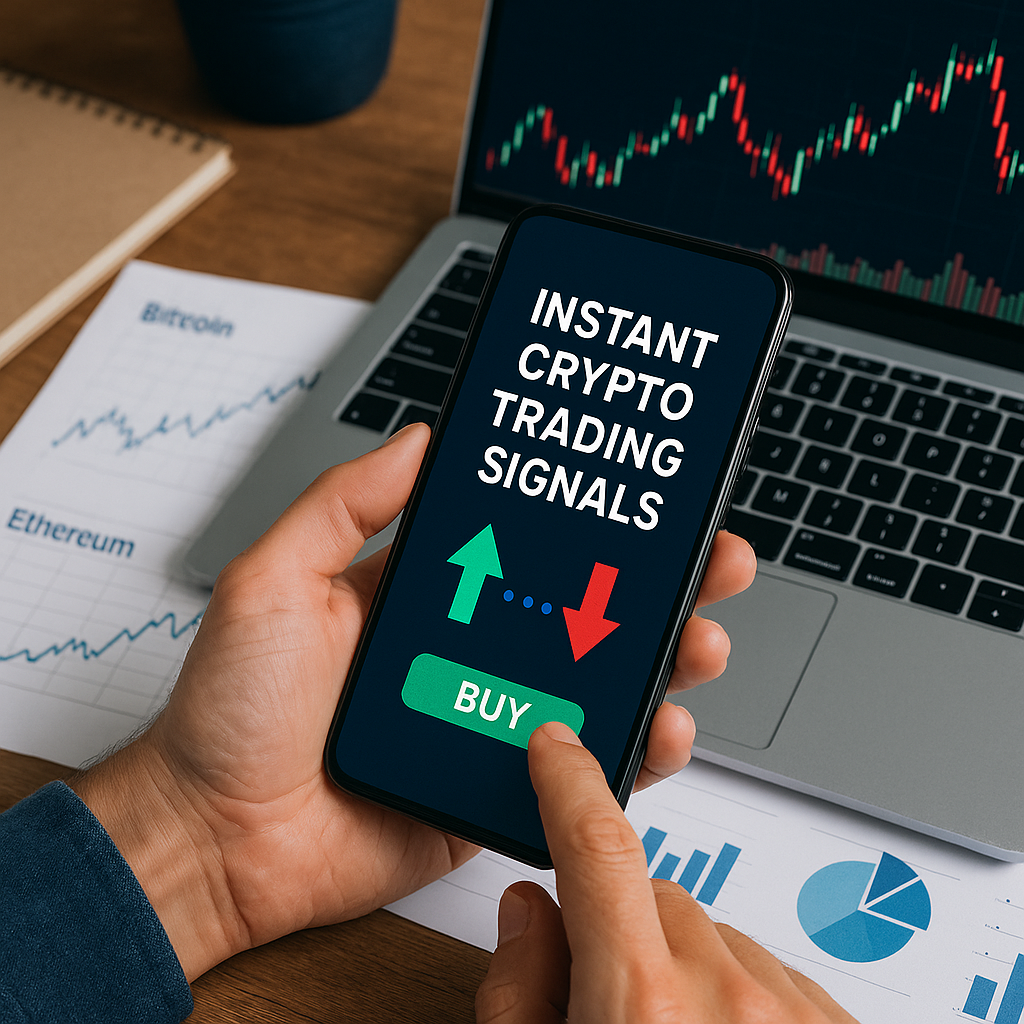
Not all crypto instant trading signals are built the same. Some whisper gently, others scream with urgency. The secret? Knowing which signals to follow. And when. Because in crypto, timing isn’t just everything. It’s the thing.
So, let’s take a tour of the different types of instant trading signals out there. And don’t worry. We’ll keep it simple, snappy, and straight to the point.
1. Scalping Signals – Blink and You’ll Miss It
Scalping is fast. Like, lightning fast. We’re talking in-and-out trades that happen within minutes, sometimes seconds.
Scalping signals are for those who live on the edge. These alerts tell you when there’s a super short-term opportunity. Just enough price movement to pocket a small profit. It could be a 1% swing on Bitcoin. Or a quick pump on a lesser-known altcoin.
Why are these signals so intense? Because scalpers aim for lots of tiny wins instead of big home runs.
And guess what? Some scalping signals are even tied to whale movements. If a whale dumps a load of ETH or suddenly accumulates Solana, that moment can trigger a quick ripple. Perfect for a scalper who knows how to track crypto whales in real time.
But fair warning: Scalping isn’t for the faint-hearted. If you’re not glued to your screen (or don’t have a bot to do it for you), you might miss the window.
2. Swing Trade Signals – Ride the Waves
Next up, swing trading. This is where you catch the wave. Not the splash.
Swing trade signals are ideal for mid-term plays. They alert you when a coin’s price is about to move significantly. Usually over days or weeks. These signals look for trend reversals, breakout patterns, or consolidation phases ready to explode.
You’re not jumping in and out every hour. Instead, you’re holding a bit longer, waiting for the momentum to carry you.
Swing signals often come with charts, zones, and confidence ratings. And because they’re a bit slower, they give you time to think, plan, and breathe. Perfect for traders who want a mix of speed and strategy. Plus, here are the best crypto swing trading strategies for traders looking to win big in this space.
3. Long-Term Position Signals – HODL with Purpose
Sometimes, the best signal isn’t the loudest. It’s the one that says, “Buy now, sit tight, and come back in three months.”
These are long-term position signals. Alerts meant for investors, not day traders. You won’t find dramatic candlestick breakdowns here. Instead, they’re based on broader market cycles, macro trends, and often, strong fundamentals.
These signals might point to coins with low market caps but high potential. Or they may highlight dips in major coins that are historically good buying zones.
Basically, these are for the “HODL” crowd. But with strategy, not guesswork.
4. Arbitrage Opportunities – The Hidden Profits
Arbitrage is a fancy word for a simple concept: Buy low here, sell high there. Crypto markets are fragmented. Prices for the same coin can vary across different exchanges. And guess what? Some signal systems are designed to sniff out these gaps in real time.
Arbitrage signals tell you when, say, Litecoin is trading at $89 on Exchange A but $91 on Exchange B. If you’re quick (or using a bot), that $2 gap can turn into easy profit.
These signals work best when you’ve got accounts on multiple exchanges and can act quickly. It’s a smart way to profit. Without predicting price movement at all.
5. Signals Based on Technical Indicators – The Science Behind the Signal
Finally, let’s talk about the signals powered by technical indicators. These aren’t random alerts. They’re data-driven, math-backed, and surprisingly reliable when used right. Here are a few MVPs:
- MACD (Moving Average Convergence Divergence): Great for spotting trend changes.
- RSI (Relative Strength Index): Tells you if an asset is overbought or oversold.
- Bollinger Bands: Signal volatility squeezes. Great for predicting breakouts.
Most real-time platforms integrate these into their alerts. You’ll get a signal that says something like: “BTC crossing over 70 RSI. Potential reversal incoming.” Even if you’re not a chart nerd, learning the basics of these indicators can help you understand why a signal was triggered. That way, you’re not just following. You’re learning.
Finally
Each type of instant trading signal has its rhythm. Fast-paced scalps, patient position plays, sneaky arbitrage wins. They all have their place in the market. What matters is matching the right type of signal to your style of trading.
And remember: whether you’re riding the short waves or going deep long-term, knowing how to track crypto whales, follow smart indicators, and react in real time can take your trades from good to great.
Top Features to Look For in a Crypto Signal Provider
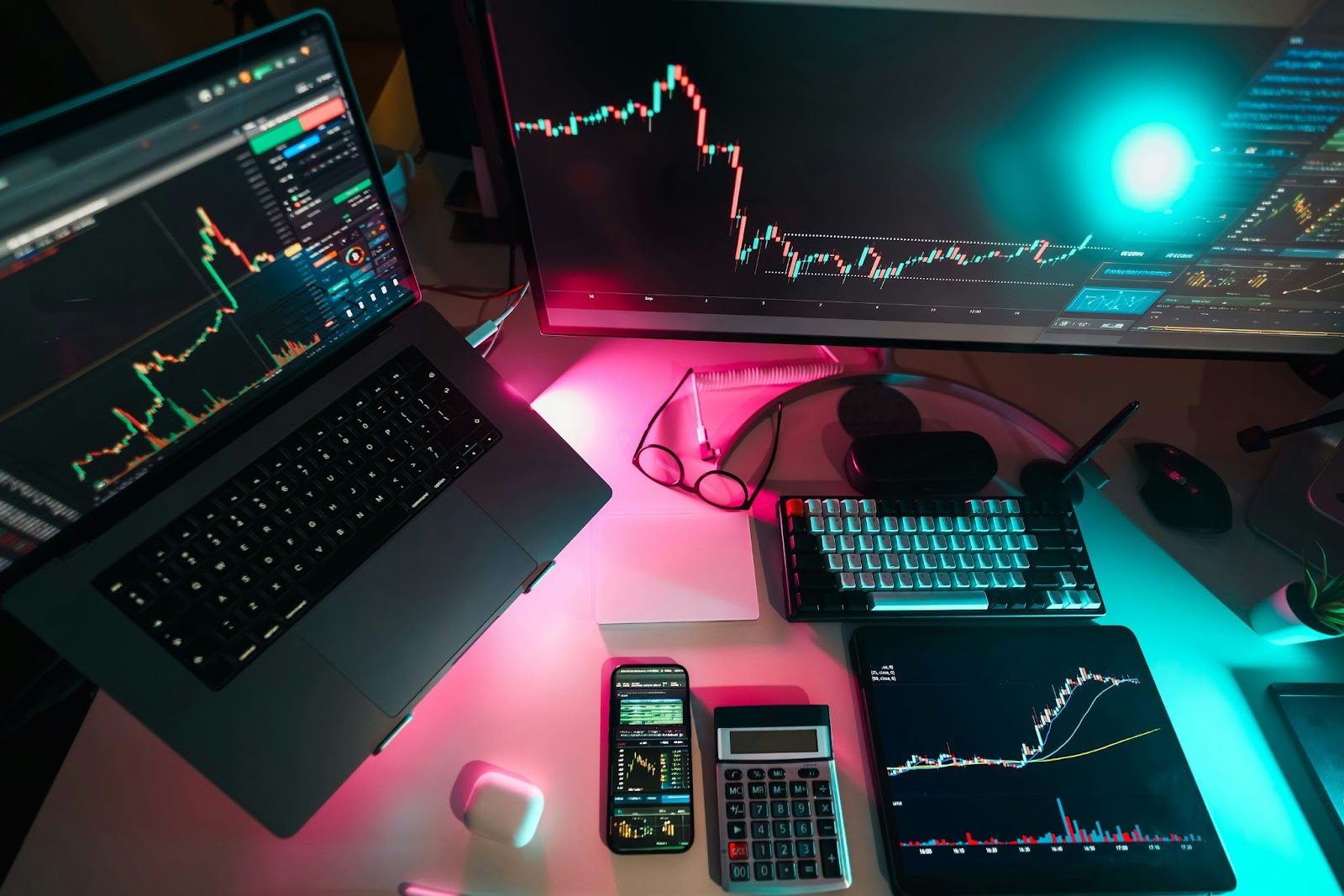
Not all crypto signal providers are created equal. Some promise the moon but deliver noise. Others quietly guide you toward profit, like a compass in a storm. The difference? It’s all in the features.
So, if you’re serious about making the most out of real-time crypto trading signals, you need to know what makes a provider truly worth your time. And maybe even your money.
Here’s your personal checklist:
Speed and Accuracy — The Non-Negotiables
In crypto, timing isn’t a luxury. It’s survival.
You want a provider that delivers signals as they happen, not ten minutes later when the move is already over. Real-time alerts are only useful if they hit your phone or screen before the price jumps (or crashes).
But it’s not just about being fast. It’s about being right. So always ask:
- How accurate are their alerts?
- Do they over-signal just to sound busy?
- Do they include stop-loss and take-profit suggestions?
Fast signals without precision are just noise. But when speed meets accuracy? That’s where the magic happens.
Signal Success Rate — The Track Record Test
Ever been in a signal group that shouted “1000x INCOMING” every other day? Yeah, don’t fall for hype. Fall for results. A credible crypto signal provider should show you their past performance. That means:
- Transparent trade history
- Win/loss ratios
- Entry and exit points that match the market
Some even offer performance dashboards you can audit yourself. Others post weekly recaps or live trade logs. And here’s a tip: if a provider can’t show you any data to back up their claims, walk away. Confidence without proof is just marketing.
Type of Analysis — Who (or What) Is Behind the Curtain?
Great signals don’t appear out of thin air. They’re built on solid cryptocurrency market analysis. But where does that analysis come from? That’s where things get interesting.
Some providers are run by human experts. Traders with years of experience, reading charts like bedtime stories. Others rely on AI algorithms that process data at lightning speed, spotting trends no human eye could catch.
Then there are community-driven groups, where crowdsourced insight becomes a hive mind of alerts and analysis. Each has its perks:
- AI gives you speed and scale.
- Human analysts offer reasoning and context.
- Communities often pick up on micro-trends, including how to track crypto whales? and react fast.
Ideally, look for providers who combine all three. Because when human instinct, machine precision, and crowd signals work together, the result is pure alpha.
Ease of Integration — Less Hassle, More Action
The last thing you want is to get a killer signal… and then spend five minutes scrambling to enter a trade. That’s why ease of integration matters.
Can the signal plug into your favorite exchange or bot? Can you auto-execute trades using APIs? Does it connect with tools like MetaMask, Binance, or TradingView?
Better integration means fewer delays and fewer missed opportunities. Some platforms even let you automate everything. Receive a signal, place a trade, set your stop-loss and walk away. Now that’s smart trading.
Custom Alerts & Filters — Because One Size Never Fits All
Not every signal is for you. Maybe you’re only into altcoins. Maybe you trade strictly on RSI. Or maybe you just want alerts when whales start moving Ethereum. Whatever your style, your provider should let you filter the noise. With custom alerts, you can:
- Choose specific coins or pairs
- Set price thresholds
- Filter by risk level
- Get notified only on breakout patterns, swing trades, or volume spikes
The more you can tailor your signal feed, the sharper your edge becomes.
Choosing the right crypto signal provider isn’t just about following someone else’s lead. It’s about finding the one that fits your trading rhythm.
So, whether you’re tracking whale moves, jumping on breakouts, or holding for long-term gains, make sure your signal source is fast, proven, flexible, and smart. Because in crypto, you don’t just want a signal. You want a signal that gets you there first.
Risks and Limitations of Relying on Crypto Signals
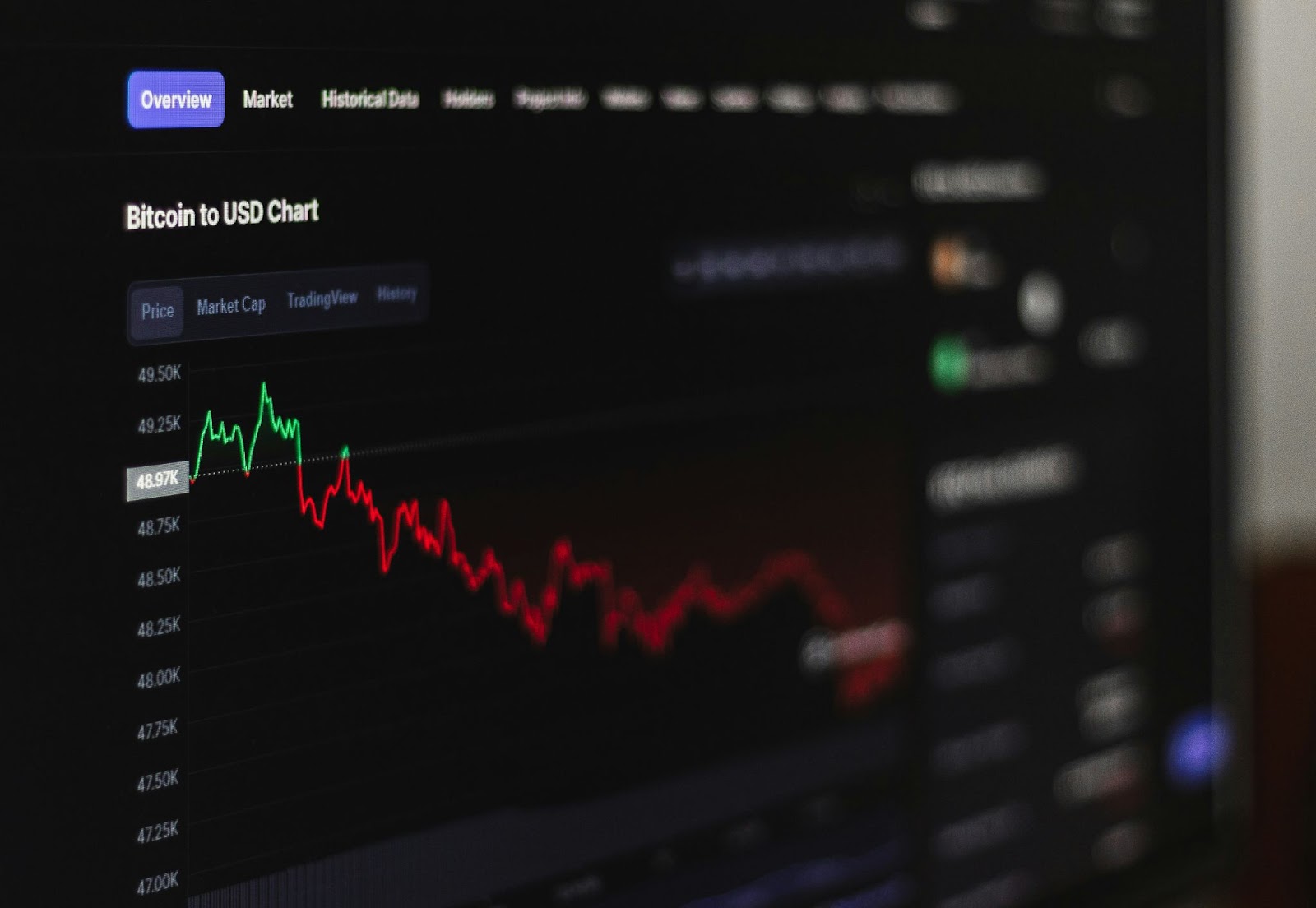
Real-time crypto trading signals can feel like a superpower. A hack that is all about a quick alert. A decisive trade. And a potential win.
But hold on.
Just because it feels invincible doesn’t mean it always is. Like every tool in crypto, signals come with their own risks, red flags, and rough edges. So before you ride into battle with your signal feed blazing, let’s take a step back. Here are the real-world limitations you should know and how to stay smart while avoiding them.
False Positives: The Signal That Cried Wolf
Not every alert is gold. Sometimes, the market gives off signals that look strong… but go nowhere. These are called false positives. These are alerts that tell you to buy or sell, but end up being dead ends.
Why does this happen?
Well, even the best algorithms can misread short-term noise as meaningful movement. A random price spike, a sudden surge in volume, or a whale playing games can all trigger alerts that look legit but fizzle out fast.
It’s like jumping into the ocean because you saw a ripple. Only to realize it was just a fish flipping its tail. So, don’t blindly follow every alert. Confirm it. Compare it. Understand why it’s being sent. That extra 30 seconds of thought can save you hours of regret.
Volatility & Slippage: The Wild Side of Crypto
Crypto doesn’t wait for anyone.
One second you’re entering a trade. The next? Price has already changed. That’s slippage. And it’s super common. Especially during high-volatility periods.
Even when you act fast on a real-time signal, the market may have already moved. You enter too late. You exit too early. Or worse, you catch the downswing while chasing the hype. Real-time crypto trading signals aim to get ahead of the curve. But even they can’t beat pure chaos. When the market moves too fast, no signal can predict the next twist perfectly.
That’s why it’s important to use stop-losses, watch price action, and keep your cool. Because sometimes, the signal is right. But the timing is just… brutal.
Scammy Signal Groups: Too Good to Be True?
We’ve all seen them.
- Telegram groups shouting “98% win rate!”
- Signal sellers flaunting screenshots of massive gains.
- “Premium VIP access” that promises you riches. For a monthly fee, of course.
Unfortunately, paid signal scams are everywhere. Many of these groups don’t actually trade. They just cherry-pick fake results, delete bad calls, and make bold promises to lure in beginners.
Some even send random buy alerts, hoping one or two hit. And when they do? They brag about them for weeks.
Here’s the truth: If someone guarantees profit in crypto, run. There are no guarantees. Just strategies, data, and risk management. So if you’re paying for a service, make sure they have:
- Transparent performance history
- Verified results
- Clear communication about risks
- No flashy hype. Just solid signals
If it smells fishy, it probably is.
DYOR: Do Your Own Research (Always)
Let’s say this as clearly as possible: No signal replaces your own brain.
Crypto signals are tools. Not commandments. They give you ideas. They highlight opportunities. But they don’t know your strategy, your risk tolerance, or your goals. That’s where DYOR (Do Your Own Research) comes in. Before acting on any alert:
- Check the chart yourself
- Look at the trend
- Consider market conditions
- Ask yourself: “Does this fit my plan?”
When you combine real-time signals with your own research, that’s where the real power is. Because now, you’re not just reacting. Rather you’re understanding.
Ultimately
Real-time crypto trading signals can be an edge. But they’re not foolproof. They can mislead, lag, or fall flat. And if you’re not careful, they can lure you into bad trades or sketchy groups.
So use them. Appreciate them. But don’t worship them.
Because in the end, the smartest trader isn’t the one who gets the most alerts. It’s the one who knows which ones to trust, and when to walk away.
Tips for Using Live Crypto Alerts Effectively

Alright, so you’ve got your signal platform set up. Your phone buzzes, your palms get sweaty, and your screen flashes: “Buy BTC Now!”
Now what?
Real-time crypto trading signals are powerful. But only if you know how to use them wisely. Otherwise, it’s like having a Ferrari but never learning how to drive.
Let’s explore ten practical, creative, and straight-up essential tips to help you make the most of those alerts. Whether you’re trading from your couch or your favorite coffee shop, these tips will keep your moves sharp, timely, and smart.
1. Don’t Jump Blindly — Pause and Verify
The signal just came in. Your heart’s racing. It’s tempting to act immediately. But stop. For just a moment. Open the chart. Look at the coin. Is it spiking? Dipping? Sideways? Use this quick pause to double-check:
- Does the alert align with the trend?
- Is it part of a larger breakout?
- What’s the volume saying?
Real-time crypto trading signals are tools, not magic spells. Take a breath. Validate the move before committing.
2. Pair Alerts with Your Own Strategy
Not all alerts fit your trading style. And that’s okay.
If you’re a swing trader, avoid chasing short-term scalping signals. If you prefer long holds, skip alerts screaming for five-minute profits. Instead, create a plan that fits you:
- Entry/exit rules
- Risk per trade
- Preferred coins or pairs
Then, let the signals support your plan. Not replace it.
3. Set Stop-Loss and Take-Profit Targets Instantly
Here’s where many traders mess up. They act on a signal, but forget to protect themselves. And in crypto? One wrong move can burn fast. So right after entering a trade, always:
- Set a stop-loss to limit downside
- Set a take-profit to lock in gains
These are your safety nets. And trust me, they matter more than the signal itself.
4. Use Multiple Sources, But Avoid Noise Overload
You don’t want to rely on a single voice. That’s risky. But too many voices? That’s chaos.
Ideally, pick 2–3 trusted signal sources. Combine human insight, algorithmic alerts, and maybe even whale tracking channels. But be selective. Don’t join 20 Telegram groups and expect clarity. The goal is confirmation, not confusion.
5. Learn the Why Behind the Signal
Ever wondered why that “Buy Now” alert appeared?
Dig a little deeper. Was it based on RSI oversold? A bullish divergence? A sudden whale transfer? The more you understand why a signal triggers, the better your intuition becomes. And one day? You’ll start spotting those setups yourself. Before the signal even arrives.
6. Use Automation (But Don’t Set It and Forget It)
Trading bots can be your best friend. Especially when working with real-time alerts.
Many platforms let you plug in signals and automate the trades instantly. But remember, bots are only as smart as their rules. So check in. Review performance. Tweak settings when the market shifts.
Automation should save you time. Not make you lazy.
7. Manage Risk Like a Pro
Here’s the golden rule: Never risk more than you can afford to lose. Seriously. Just because a signal feels strong doesn’t mean you should go all in. Follow the 1–2% rule:
- Risk only a tiny portion of your portfolio per trade.
- That way, even if five alerts flop, you live to trade another day.
- Signals are about stacking wins over time. Not chasing jackpots.
8. Time Your Notifications Right
Timing matters. But so does timely access. Make sure you receive your alerts in a way you can actually act on:
- Push notifications on your phone
- Pop-up alerts on your desktop
- Email or SMS for longer-term plays
And don’t forget time zones. If you sleep while signals fire, consider a bot or auto-trader to bridge the gap.
9. Track Your Results Religiously
You took the trade. Great. Now what? Log it. Every single one. Keep a simple trading journal:
- What was the signal?
- Did you follow your plan?
- What went right? Or wrong?
Over time, you’ll spot patterns. You’ll know which signal sources perform best. And you’ll build confidence based on data, not just gut feeling.
10. Stay Emotionally Detached
This one’s huge.
Signals remove guesswork. But they don’t remove emotion. The market might spike against you. Or dump just after your entry.
Don’t panic. Don’t chase losses. And don’t revenge trade just because an alert didn’t go your way. Trust your system. Stick to your rules. The moment you trade emotionally, you hand your edge back to the market.
In short, real-time crypto trading signals can be a serious edge. But, if you treat them like tools, not shortcuts. They offer speed, clarity, and insight. But the power still lies in how you use them.
So, take a step back. Build a routine. Use alerts as part of a bigger strategy. And most importantly, stay calm in the chaos. Because when you combine real-time signals with smart habits, you’re not just reacting anymore.
Are Real-Time Crypto Signals Worth It?

You’re here because you want to know one thing: Are real-time crypto trading signals actually worth it?
It’s a fair question. And the answer isn’t a simple yes or no. It really depends on how you use them, when you use them, and who you are as a trader.
Let’s break it all down, no fluff. Just real talk.
Cost vs Reward: Do the Numbers Add Up?
Here’s the first thing everyone wants to know: “If I’m going to pay for signals, will it actually pay off?”
Well, here’s the deal.
Some signal providers are free. Others charge $50, $100, even $500 a month. That’s a chunk of cash. But what you really want to ask is, what do you get in return? If a premium group helps you catch 2–3 solid trades a week it can absolutely be worth it.
But… if you’re not managing risk properly, if you ignore stop-losses, or if you blindly follow bad alerts, even free signals can get expensive real quick.
So, it’s not just about cost. It’s about how well you use the tools. With the right habits, real-time crypto trading signals can turn into a valuable return on investment. Without discipline? They can burn a hole in your wallet.
When Live Crypto Alerts Truly Shine: Speedy Markets and Fast Fingers
Some trading conditions scream for real-time signals. Others… not so much. Let’s look at where they shine brightest:
- Day Trading: You’re glued to the charts. Every candle matters. Real-time alerts help you act fast, spot breakouts early, and avoid missing juicy setups.
- Scalping: Even faster. You’re looking for quick price bumps. Real-time signals make all the difference here. You can’t wait minutes. You need to strike the moment the alert lands.
- High Volatility Moments: News breaks. Elon tweets. BTC dumps. The market goes wild. If you’re plugged into instant alerts, you might ride the wave instead of getting crushed by it.
In these situations, speed is everything. Signals become your early-warning system. Your shortcut to opportunity.
Now, are signals useful for long-term investors? Sure, they can be. But if you’re holding a coin for 6 months or more, you don’t need an alert every 10 minutes. It’s like checking the weather every hour when you’re planning a beach day next summer. Not helpful.
Who Should Use Crypto Signals: Beginners, Pros, or Both?
Now this is interesting.
Many people assume signals are only for beginners. Like training wheels for the trading world. But actually? Everyone can benefit. The value just changes depending on where you are in your journey.
- Beginners: Signals offer direction. They help you learn. You start recognizing chart patterns, understanding market reactions, and seeing how pro traders think. It’s education with a profit potential.
- Intermediate Traders: You’ve got some experience, but you’re looking for confirmation. Real-time alerts add a second opinion to your analysis. They back you up. Or warn you off a risky move.
- Pros: Even seasoned traders use them. Not because they don’t know what they’re doing. But because having real-time, automated insights helps streamline decision-making. And let’s be honest. No one wants to monitor 20 charts all day.
So yes, signals are for everyone. It’s not about your level. It’s about how strategically you use them.
Worth It… If You Work It
So, are real-time crypto trading signals worth it? Yes.
But not as shortcuts. Not as magic formulas. And definitely not if you plan to switch off your brain and let someone else do the thinking. They’re worth it if:
- You use them with a plan.
- You understand when and how to act.
- You view them as tools, not guarantees.
Because at the end of the day, crypto trading isn’t about reacting. It’s about responding. With logic, speed, and confidence. And the right signal, at the right time, can make all the difference.
Future of Crypto Signals: Smarter, Faster, More Personalized

The world of crypto never sits still. And neither do trading signals.
What started as simple buy-sell alerts in Telegram groups is now evolving into something far more powerful. Smarter, faster, and yes, deeply personalized. The future of real-time crypto trading signals isn’t just about reacting to the market… it’s about predicting it. In fact, the game is changing completely.
Let’s take a peek into what’s coming next. And why it might just blow your mind.
Machine Learning & Predictive Models: Signals That Think Ahead
Right now, most crypto signals work by scanning the present. Real-time charts, live order books, current patterns. But machine learning? It looks to the future.
These AI-driven models don’t just see what’s happening now. They analyze vast amounts of historical data to forecast what’s likely to happen next. Here’s what they’re learning to do:
- Spot hidden patterns in candle movements
- Identify early signs of whale accumulation
- Detect pre-pump setups hours in advance
- Predict volatility before it kicks in
Imagine getting an alert before the breakout even starts. Because an algorithm recognized the exact setup that caused similar moves in the past. That’s not fantasy anymore. That’s happening.
And the best part? These models improve over time. The more data they digest, the smarter they get. So, the signals don’t just get faster. They get better.
Sentiment-Based Signals: Trading on the Crowd’s Emotions
Sometimes, the charts don’t tell the whole story. Sometimes, the market moves not because of a pattern… but because of a tweet.
Enter sentiment-based signals. These alerts monitor social platforms like Twitter (X), Reddit, YouTube, and Telegram in real time. They use natural language processing (NLP) to track:
- Bullish or bearish chatter
- Trending hashtags
- Influencer comments
- Viral crypto news
Then, they translate that emotional energy into actionable alerts.
Let’s say Dogecoin suddenly starts trending again because Elon dropped a one-word tweet. A sentiment-based signal catches that spike in social buzz and sends an alert. Long before the price even moves.
It’s like trading with your ear to the street. But automated. In a world where meme coins moon and crash in hours, tracking hype is no longer optional. It’s a strategy. And it’s fast becoming one of the most valuable tools in the crypto signal toolkit.
Web3 Integration: Signals Meet Your Wallet
Now let’s talk about personalization. The next wave of real-time crypto trading signals won’t just send you alerts. They’ll talk to your wallet.
Thanks to Web3 tech, signal platforms are being integrated directly into decentralized wallets and dApps. That means:
- You get signals based on the tokens you hold
- Alerts are customized to your actual portfolio
- You can react instantly. Without leaving your wallet
No more copy-pasting signals from Telegram to your exchange. No more switching tabs or juggling apps. You’ll be able to receive, review, and act on a signal all from one place.
Even better? Smart contracts can automate this further. Imagine setting a rule like: “If ETH hits this signal and volume spikes 15%, execute a 10% buy.” Your wallet listens, then acts. That’s not science fiction. That’s where we’re heading.
The Signal Revolution Is Here
Crypto trading signals are no longer just about speed. They’re about intelligence.
The future lies in smarter models, emotion-aware algorithms, and ultra-personalized tools that respond to you, not just the market.
So, while the crypto space keeps evolving, your trading edge doesn’t have to lag behind. Whether it’s AI forecasting a pump, social buzz predicting a breakout, or your wallet trading for you. This is the new era of crypto signals.
And it’s coming fast.
Don’t Just React — Trade Smart
Timing can change everything in crypto space. That’s why real-time crypto trading signals matter. They help you act smarter, faster, and with more clarity. But here’s the thing: they’re not magic. They won’t trade for you. They won’t protect you from poor decisions.
Still, when used right, with strategy, discipline, and just a touch of curiosity, they can sharpen your edge and open up new opportunities. So whether you’re chasing breakouts or tracking whales, let signals guide your moves. Not control them.
Thus, stay alert. Stay sharp. And most importantly, trade with purpose.
Frequently Asked Questions (FAQ)
1. How accurate are real-time crypto alerts?
Accuracy can vary depending on the provider, market conditions, and type of signal. Some premium platforms claim win rates between 60–80%, but no signal is 100% foolproof. Real-time alerts work best when combined with your own research and risk management. Use them as guidance. Not a guarantee.
2. Can I automate trades using these signals?
Yes, absolutely. Many real-time crypto signal providers offer integration with trading bots and APIs. This allows you to automate buy/sell orders as soon as a signal is triggered. Just make sure your bot follows a clear set of rules, and always monitor your setup. Automation isn’t “set it and forget it.”
3. Are crypto signals legal and safe to use?
Yes, using crypto signals is legal in most countries. But the safety part? That depends on who you’re getting them from. Stick to reputable platforms or verified communities. Avoid shady Telegram groups promising guaranteed profits or “VIP insider tips.” Always do your due diligence before following or paying for any service.
4. Do I need trading experience to use live crypto alerts?
Not necessarily. Beginners can benefit from signals to learn patterns and trading setups. But experience helps you filter out weak signals and avoid emotional decisions. Over time, you’ll start understanding the “why” behind the alerts. And that’s when signals really become powerful.

